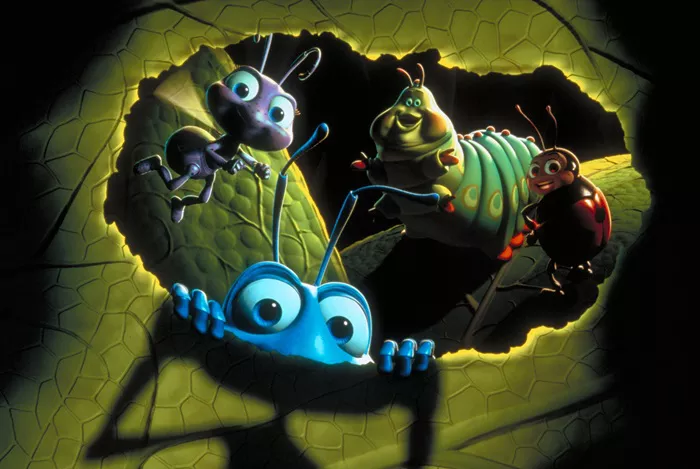“A Bug’s Life,” produced by Pixar Animation Studios and released by Walt Disney Pictures in 1998, stands as a pioneering film in the realm of computer animation. Directed by John Lasseter, with co-direction by Andrew Stanton, this film, only the second feature-length release by Pixar following the monumental success of “Toy Story,” helped cement Pixar’s reputation as a leader in animated cinema. Spanning a tight 95 minutes, “A Bug’s Life” not only dazzles with its technical brilliance but also charms with its storytelling and complex character dynamics. This article explores the various aspects of “A Bug’s Life,” analyzing its impact, themes, and legacy within the animation industry.
Plot Overview and Character Introduction
“A Bug’s Life” presents a vibrant and richly detailed narrative that follows Flik, an inventive but occasionally misguided ant, who embarks on a quest to find warriors to save his colony from oppressive grasshoppers. The film opens in an ant colony on an island in the middle of a river, where the ants are preparing their annual offering to the grasshoppers. When Flik accidentally destroys the food, he proposes to recruit fighters to defend the colony from the grasshoppers’ tyranny.
The characters in “A Bug’s Life” are crafted with care and depth. Flik stands out as the innovative ant whose unorthodox ideas initially cause trouble but eventually bring salvation to his colony. The ensemble of misfit bugs that Flik recruits—including a ladybug, a stick insect, and a caterpillar—brings a delightful mix of humor and heart to the story, each adding a unique element to the team.
Technical Innovations in Animation
At its release, “A Bug’s Life” was at the forefront of animation technology. Pixar utilized Subdivision Surfaces for modeling for the first time, allowing for smoother and more organic shapes in the characters, a significant enhancement over the stiffer models used in “Toy Story.” The film also showcased vast improvements in the rendering of natural environments, creating detailed and immersive backgrounds that enhanced the storytelling. This technical prowess not only showcased Pixar’s ability to push boundaries but also set new standards for what audiences could expect from animated films.
Thematic Depth
Beyond its technical achievements, “A Bug’s Life” thrives on its exploration of themes such as individuality, innovation, and the importance of community and teamwork. Flik’s journey is one of self-discovery, where his initial failures lead to profound growth and eventually, triumph. This resonates with audiences of all ages, making the film more than just a visual spectacle—it becomes a story with heart and soul.
Critical Reception and Box Office Performance
Upon release, “A Bug’s Life” received generally positive reviews from critics, who praised its animation and humor, though some noted it as less groundbreaking compared to “Toy Story.” The film was a box office success, grossing over $363 million worldwide. It demonstrated that Pixar’s appeal was no fluke and that the studio could consistently deliver quality content that entertained children and adults alike.
Cultural Impact and Legacy
The legacy of “A Bug’s Life” is multifaceted. It solidified Pixar’s reputation as a studio capable of producing high-quality animations that were technically superior and richly narrated. The film also contributed to the evolution of the animation genre, influencing numerous animated films that followed. Characters like Flik have become emblematic of innovation and resilience, inspiring audiences and other creators in the field.
Comparative Analysis with Contemporary Works
Comparing “A Bug’s Life” to other animations of the time, such as “Antz,” which was released by DreamWorks in the same year, provides insight into the competitive nature of animated films during the late 1990s. While both films feature ant colonies and similar themes of individual struggle against societal norms, “A Bug’s Life” is often noted for its lighter tone and appeal to younger audiences, whereas “Antz” targeted a somewhat older demographic.
Educational and Merchandising Exploits
The educational potential of “A Bug’s Life” has been tapped through various means, including video games, educational software, and themed attractions at Disney parks. Merchandising has also played a significant role in maintaining the film’s popularity among subsequent generations, with toys, clothing, and other products keeping the characters in the public eye.
Conclusion
“A Bug’s Life,” with its 95-minute runtime, does more than just entertain. It offers lessons on perseverance, innovation, and the strength of community, all wrapped in a package of pioneering animation techniques. As Pixar’s second feature film, it was a critical step for the studio in establishing a lasting legacy in the animation industry. Two decades later, the film remains a beloved classic, reflecting the enduring quality of Pixar’s early work. Its blend


